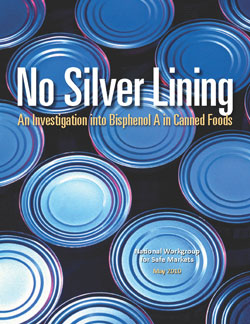 By Erika Schreder, Staff Scientist, Washington Toxics Coalition
By Erika Schreder, Staff Scientist, Washington Toxics Coalition
Nine out of ten. According to a study released today, those are your chances of having some bisphenol A (BPA) with tonight’s dinner, if canned food is on your menu. New testing for BPA sampled 50 cans of food and drinks, and found that the hormone-disrupting chemical is a near ubiquitous presence in canned food.
The study, titled No Silver Lining and published by the National Work Group for Safe Markets, found what appears to be the highest level of BPA ever detected in canned food. A can of Del Monte green beans from a Wisconsin pantry clocked in at 1140 parts per billion BPA, several times greater than the highest levels reported by other recent studies.
Dr. Laura Vandenberg, a leading BPA researcher at Tufts University, reviewed the results.
“The levels found in this study are definitely concerning, and indicate that the time has come to remove this chemical from food cans,” she said.
BPA turns up in canned food because it is a component of the epoxy lining used in most cans in the United States. But it’s not the only option: Eden Foods has used an alternative for most of its cans for several years, and General Mills recently announced that its cans of Muir Glen tomatoes will soon be BPA-free.
[pullquote]/While public attention has focused on the use of BPA in baby bottles, its presence in canned food is potentially even more troubling./[/pullquote] Research on BPA indicates children’s period of greatest vulnerability comes before they’re using baby bottles—it’s before they’re born. And if their moms are exposed to BPA during pregnancy, the chemical travels to the fetus where it can disrupt development in a number of ways.
Bobbi Chase Wilding, report co-author and study participant, was pregnant when she submitted a sample of canned food from her pantry for testing. She reflected,
“As a mother of two daughters, I’ll always wonder if BPA exposure during pregnancy and while breastfeeding will play a role in their health. It’s a risk I wouldn’t have taken willingly, and one no mother should have to take at all.”
* Peaches for breakfast: 0.94 micrograms BPA
* Lentil soup for lunch: 19.5 micrograms BPA
* Tuna casserole for dinner: 62 micrograms BPA
* Bananas with coconut milk for dessert: 4.9 micrograms BPA
Grand total for one day’s meals: 87 micrograms BPA
Day’s exposure for an average-sized woman: 1.23 micrograms BPA per kilogram body weight
* Exposure leading to reproductive and cancer-related effects: 1 microgram BPA/kg body weight
* Exposure leading to altered development of fetal mammary glands: 0.25 micrograms BPA/kg body weight
* Exposure leading to permanent changes to genital tract: 0.025 micrograms BPA/kg body weight
To calculate how much BPA we are actually ingesting from
canned food, the study authors created hypothetical menus and added up the dose
based on the study results. They found that an averaged-sized woman who
consumed any of the three sample menus would be exposed to BPA at higher levels
than those that caused reproductive problems and increased chances of breast
cancer in laboratory studies.
Given the lack of any margin of safety with BPA exposures just from this one source—canned food—advocates are calling for immediate action to replace BPA in can linings with safer materials. Nationally, the Senate is expected to vote soon on the Food Safety Modernization Act, which could include a phaseout of BPA in food and drink containers.
The Safe Chemicals Act, recently introduced in Congress, could have broader impact on BPA and other chemicals that disrupt hormones, harm the nervous or reproductive system, or cause cancer. Join the Safer Chemicals, Healthy Families coalition in asking Congress to strengthen the Act to make sure that it includes strict timelines for reducing the use of such chemicals. Maybe hormone disruptors and cancer-causing chemicals won’t be on the dinner menu in 2012.



